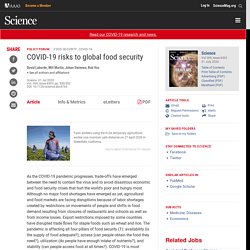

Conceptual model for understanding the rapid COVID-19–related increase in food insecurity and its impact on health and healthcare. Skip to Main Content Advertisement Search Close Advanced Search Search Menu Skip Nav Destination Article Navigation Volume 112 Issue 5 November 2020 Article Contents Editor's Choice A conceptual model for understanding the rapid COVID-19–related increase in food insecurity and its impact on health and healthcare Anna M Leddy, Anna M Leddy Department of Medicine, University of California , San Francisco, San Francisco, CA, Address correspondence to AML (e-mail: anna.leddy@ucsf.edu) Search for other works by this author on: Oxford Academic Google Scholar Sheri D Weiser, Sheri D Weiser Oxford Academic Google Scholar Kartika Palar, Kartika Palar Oxford Academic Google Scholar Hilary Seligman Hilary Seligman Department of Epidemiology and Biostatistics, University of California Oxford Academic Google Scholar The American Journal of Clinical Nutrition, Volume 112, Issue 5, November 2020, Pages 1162–1169, Published: 07 August 2020 Article history Received: 26 May 2020 Accepted: 20 July 2020 Topic: Issue Section: Narrative Review Notes Yeh.

How will the COVID 19 pandemic shape the future of meat consumption? The Early Food Insecurity Impacts of COVID-19. Addressing the COVID-19 Nutrition Crisis in Vulnerable Communities: Applying a Primary Care Perspective - Madeline Mae Ong, Ronnah Marie Ong, Gladys Kaye Reyes, Lourdes Bernadette Sumpaico-Tanchanco, 2020. COVID-19 risks to global food security. Farm workers using the H-2A temporary agricultural worker visa maintain safe distance on 27 April 2020 in Greenfield, California.

As the COVID-19 pandemic progresses, trade-offs have emerged between the need to contain the virus and to avoid disastrous economic and food security crises that hurt the world's poor and hungry most. Although no major food shortages have emerged as yet, agricultural and food markets are facing disruptions because of labor shortages created by restrictions on movements of people and shifts in food demand resulting from closures of restaurants and schools as well as from income losses. Export restrictions imposed by some countries have disrupted trade flows for staple foods such as wheat and rice. The pandemic is affecting all four pillars of food security (1): availability (is the supply of food adequate?)
, access (can people obtain the food they need?) Innovations in Agriculture and Food Supply in Response to the COVID-19 Pandemic. Climate change and COVID-19: reinforcing Indigenous food systems - The Lancet Planetary Health. Indigenous populations are at especially high risk from COVID-19 because of factors such discrimination, social exclusion, land dispossession, and a high prevalence of forms of malnutrition.

Anderson I Robson B Connolly M et al. Indigenous and tribal peoples' health (The Lancet–Lowitja Institute Global Collaboration): a population study. Lancet. 2016; 388: 131-157 Climate change is compounding many of these causes of health inequities, undermining coping mechanisms that are traditionally used to manage extreme events such as pandemics, and disrupting food systems and local diets. Ford JD King N Galappaththi EK Pearce T McDowell G Harper SL The resilience of Indigenous Peoples to environmental change. One Earth. 2020; 2: 532-543 Addressing underlying structural inequities and strengthening Indigenous knowledge systems offer opportunities for building resilience to compound socioecological shocks, including climate effects and pandemics. Mamelund S-E Sattenspiel L Dimka J Brascoupé S Waters C. Food waste management during the COVID-19 outbreak: a holistic climate, economic and nutritional approach. 1.

Introduction The emergent coronavirus disease, COVID-19, presents a significant and critical threat to worldwide health since its outbreak in early December 2019 (Wu et al., 2020). In order to reduce and delay community transmission, diminishing the burden on healthcare systems, while also providing the best possible care for patients, most regions and nations have enforced exceptional public health measures together with unprecedented social and economic interventions (IMF, 2020).
Community-based measures include actions taken by national and/or regional governments, and companies to protect vulnerable groups, employees and the overall population. The measures carried out, which include interventions within workplaces, educational centers, public transportation, spiritual and cultural venues, among others, aim to decrease transmission through changes in behavior to levels that can be managed by current health care capacity (Cornwall, 2020). 2. 2.1. 2.2.
Fig. 1. 2.3. Table 1. 2.3.1. COVID-19 and disruptions to food systems. New opportunities for the redesign of agricultural and food systems. Food delivery service during social distancing: Proactively preventing or potentially spreading COVID-19? Converting Home Spaces into Food Gardens at the Time of Covid-19 Quarantine: all the Benefits of Plants in this Difficult and Unprecedented Period.
Baby pangolins on my plate: possible lessons to learn from the COVID-19 pandemic.